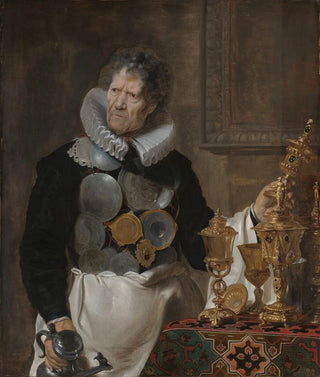Painting Abraham Grapheus - Cornelis de Vos | Art print


View from behind

Frame (optional)
Abraham Grapheus - Cornelis de Vos Art print
In the vast panorama of art history, some works manage to capture the essence of an era while transcending time. The Abraham Grapheus - Cornelis de Vos art print is one of those iconic pieces that fascinate art lovers and curious minds alike. This painting, depicting a scene rich in symbolism and emotion, immerses us in the complex and vibrant universe of 17th-century Flemish painting. Through this piece, viewers are invited to explore not only the pictorial techniques of the period but also the social and cultural dynamics that shaped it.
Style and uniqueness of the work
What immediately strikes in this piece is the mastery of light and shadow, a characteristic trait of the Flemish school. The colors, both vibrant and nuanced, confer unparalleled depth to the depicted characters. Every detail, from sumptuous drapery to delicate facial expressions, demonstrates exceptional craftsmanship. Abraham Grapheus, as a portraitist, manages to capture the soul of his subjects, revealing their inner thoughts and emotions. The composition, skillfully orchestrated, guides the viewer’s gaze through the scene, creating an almost intimate interaction between the work and its observer. This painting does not merely depict figures; it tells a story, that of a time when art reflected the aspirations and values of a society in full transformation.
The artist and his influence
Abraham Grapheus, although less known than some of his contemporaries, plays a crucial role in the evolution of Flemish painting. His works, marked by a unique sensitivity, testify to a deep understanding of human nature. Grapheus drew inspiration from the masters of his time while developing a personal style that is entirely his own. His influence extends beyond his own work, inspiring many artists who followed in his footsteps. By incorporating elements of daily life into his portraits, he paved the way for a new approach to the genre, where the individual is highlighted in all their complexity. The themes he explores, often imbued with morality and reflection, still resonate today, making his

Matte finish

View from behind

Frame (optional)
Abraham Grapheus - Cornelis de Vos Art print
In the vast panorama of art history, some works manage to capture the essence of an era while transcending time. The Abraham Grapheus - Cornelis de Vos art print is one of those iconic pieces that fascinate art lovers and curious minds alike. This painting, depicting a scene rich in symbolism and emotion, immerses us in the complex and vibrant universe of 17th-century Flemish painting. Through this piece, viewers are invited to explore not only the pictorial techniques of the period but also the social and cultural dynamics that shaped it.
Style and uniqueness of the work
What immediately strikes in this piece is the mastery of light and shadow, a characteristic trait of the Flemish school. The colors, both vibrant and nuanced, confer unparalleled depth to the depicted characters. Every detail, from sumptuous drapery to delicate facial expressions, demonstrates exceptional craftsmanship. Abraham Grapheus, as a portraitist, manages to capture the soul of his subjects, revealing their inner thoughts and emotions. The composition, skillfully orchestrated, guides the viewer’s gaze through the scene, creating an almost intimate interaction between the work and its observer. This painting does not merely depict figures; it tells a story, that of a time when art reflected the aspirations and values of a society in full transformation.
The artist and his influence
Abraham Grapheus, although less known than some of his contemporaries, plays a crucial role in the evolution of Flemish painting. His works, marked by a unique sensitivity, testify to a deep understanding of human nature. Grapheus drew inspiration from the masters of his time while developing a personal style that is entirely his own. His influence extends beyond his own work, inspiring many artists who followed in his footsteps. By incorporating elements of daily life into his portraits, he paved the way for a new approach to the genre, where the individual is highlighted in all their complexity. The themes he explores, often imbued with morality and reflection, still resonate today, making his
12,34 €






